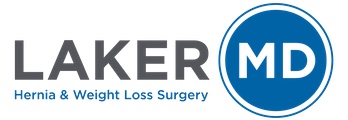Hernias of the Groin - Femoral Hernia
The groin is the lowest part of the abdominal wall. The area spans from the top of the iliac crest (hip bone) across the abdomen and extends down to the pubic bone and the junction of the thigh and lower abdomen.
Femoral Hernia
The femoral canal is the passageway from which the arteries and veins of the abdomen pass through the boney pelvis and to the legs. A femoral hernia refers to a hernia within the femoral canal. The femoral canal is bordered by the pelvis toward the midline and the femoral vein laterally. The area between the bone and vein contains fat and lymph nodes. As people age this fat may diminish leaving a larger space between the bone and vessels. As the space enlarges the opening can permit passage of bowel causing obstruction and potentially severe consequences. Unlike the soft tissue of the groin the pelvic bone will not relax to accommodate a hernia increasing the potential for strangulation. Femoral hernias are more prevalent in women although it is still only seen in 1-3% of all groin related hernias.
How are hernias repaired?
Inguinal hernias can be repaired in an open or laparoscopic fashion both with and without mesh. Mesh free repairs are referred to as primary repairs and several techniques have been described over the last century. In the past 30 years the use of mesh has become increasingly used. At this time most surgeons will use mesh as it has been demonstrated to reduce the incidence of hernia recurrence. In the last 20 years there has been increasing use of laparoscopic techniques to repair groin hernias. Laparoscopic techniques almost always require mesh for satisfactory repair.
What is the difference between open and laparoscopic techniques?
The open repair requires a 4-6 inch oblique incision in the groin. The hernia(s) are identified and reduced (pushed back into place). Mesh is typically placed on top of the inguinal floor increasing its strength and durability and covering the potential openings through which tissue can slide. This is referred to as an “onlay” technique.
The laparoscopic techniques allow complete visualization of the inguinal region including the femoral space. Once the anatomy is delineated and the hernia(s) are reduced, mesh is placed under the abdominal wall defects. This is referred to as an “underlay”.
What are the advantages of the laparoscopic techniques?
Laparoscopic hernia repair allows repair of both sides simultaneously through three small incisions. Laparoscopic repair has also been demonstrated to be beneficial in those patients who are undergoing surgery for recurrent inguinal hernias. The recovery is generally quicker and with less pain and swelling. Patients are generally able to return to work sooner and most patients can return to full activity within 3 to 4 weeks.
Recovery from open surgical repair is highly variable but most patients will experience significant groin discomfort and swelling for days to weeks. Return to full activity generally occurs 6 weeks after surgery.

